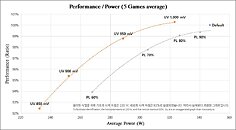- Joined
- Oct 9, 2007
- Messages
- 47,845 (7.39/day)
- Location
- Dublin, Ireland
| System Name | RBMK-1000 |
|---|---|
| Processor | AMD Ryzen 7 5700G |
| Motherboard | Gigabyte B550 AORUS Elite V2 |
| Cooling | DeepCool Gammax L240 V2 |
| Memory | 2x 16GB DDR4-3200 |
| Video Card(s) | Galax RTX 4070 Ti EX |
| Storage | Samsung 990 1TB |
| Display(s) | BenQ 1440p 60 Hz 27-inch |
| Case | Corsair Carbide 100R |
| Audio Device(s) | ASUS SupremeFX S1220A |
| Power Supply | Cooler Master MWE Gold 650W |
| Mouse | ASUS ROG Strix Impact |
| Keyboard | Gamdias Hermes E2 |
| Software | Windows 11 Pro |
The monstrous NVIDIA GeForce RTX 4090 "Ada" graphics card has the potential to be a very efficient high-end graphics card with a daily-use undervolt, and with its power-limit halved, finds an undervolting adventure review by Korean tech publication Quasar Zone. The reviewer tested the RTX 4090 with a number of GPU core voltage settings, and lowered software-level power-limits (down from its 450 W default).
It's important to note that 450 W is a very arbitrary number for the RTX 4090's power limit, the GPU rarely draws that much power in typical gaming workloads. Our own testing at stock settings sees its gaming power draw around the 340 W-mark. Quasar Zone tested the RTX 4090 with a power limit as low as 60% (270 W). With its most aggressive power management they could muster (i.e. 270 W PL), the card was found to lose just around 8% of performance at 4K UHD, averaged across five AAA games at maxed out settings. The story is similar with undervolting the GPU down to 850 mV, down from its 1 V stock. In both cases, the performance loss appear well contained, while providing a reduction in power-draw (in turn heat and noise).



View at TechPowerUp Main Site | Source
It's important to note that 450 W is a very arbitrary number for the RTX 4090's power limit, the GPU rarely draws that much power in typical gaming workloads. Our own testing at stock settings sees its gaming power draw around the 340 W-mark. Quasar Zone tested the RTX 4090 with a power limit as low as 60% (270 W). With its most aggressive power management they could muster (i.e. 270 W PL), the card was found to lose just around 8% of performance at 4K UHD, averaged across five AAA games at maxed out settings. The story is similar with undervolting the GPU down to 850 mV, down from its 1 V stock. In both cases, the performance loss appear well contained, while providing a reduction in power-draw (in turn heat and noise).



View at TechPowerUp Main Site | Source






 Imagine a 4090 was the size of a low profile GTX1650. But it is 4090 and you are looking at your mega-build with a $600 motherboard and the biggest RGB ram sticks you can get....how would that make you feel? Your sound card and your RAM is bigger than your video card? It's like buying a Ford car with a 1.0 Eco engine....looks like it's built from lego bricks.
Imagine a 4090 was the size of a low profile GTX1650. But it is 4090 and you are looking at your mega-build with a $600 motherboard and the biggest RGB ram sticks you can get....how would that make you feel? Your sound card and your RAM is bigger than your video card? It's like buying a Ford car with a 1.0 Eco engine....looks like it's built from lego bricks. 